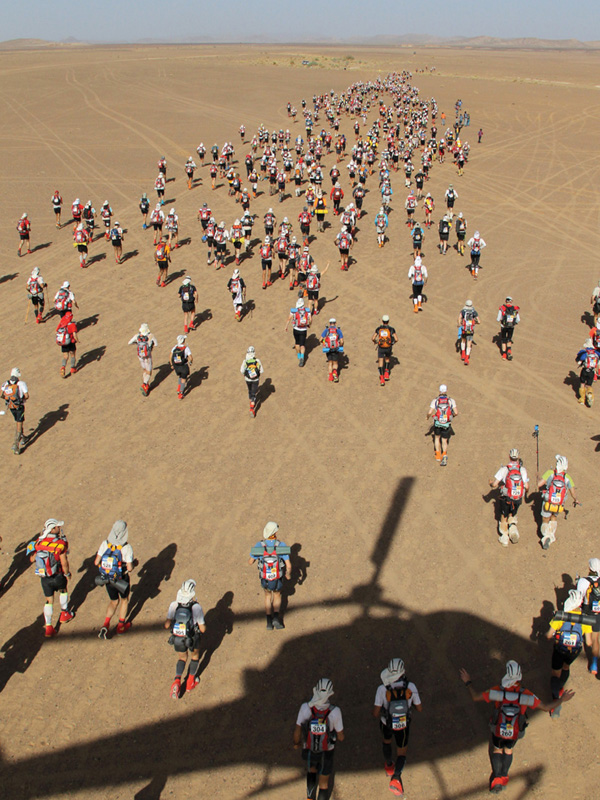
WHAT IT IS The endurance event to top them all
WHY YOU WON’T DO IT Because multiple marathons in the desert are not most people’s cup of tea
If you’re bored of simple marathons and want a challenge on an entirely different plane, look no further than the Marathon des Sables, a six-day ultramarathon through the Sahara desert in southern Morocco. As the saying goes: ‘Any idiot can run an ultramarathon but it takes a special kind of idiot to run the Marathon des Sables.’
First run in 1986, the race route takes in 251 kilometres (156 miles) – equivalent to almost six ordinary marathons. However, the stages are not of equal length – the shortest is a comparatively brief 21 kilometres (13 miles), while the longest is a gruelling 88.5 kilometres (55 miles). Little wonder it’s widely regarded as the hardest foot race in the world, with two recorded fatalities among competitors over the years.
This is a race all about long preparation. Ideally, start thinking about your training schedule a good 18 months in advance – don’t expect to be able to deal with the demands placed upon your body and spirit if you have only managed a couple of jogs around the local park in the build-up. It’s not uncommon for the temperature to hover around 40 °C (104°F), so if you can get in some warm-weather training, it is highly recommended. A Legionnaire hat and a good sun block are also worth their weight in gold. The total cost of competing (including entry fee) is estimated at around US$5,000.
Decide whether you are aiming simply to finish, or whether you have a chance of competing at the front. The winner in 2011 won in just under 21 hours, maintaining a pace equivalent to running a normal marathon every three and a half hours. Speak to people who have competed and read about their experiences – there is no better way of finding out what lies ahead of you.
As well as building up fitness and speed, focus on preparing your feet – they’ll need to be healthy, supple and resilient. The extreme heat causes feet to swell, so it is a good idea to run in trainers that are initially too big. Blisters are the main reason that runners have to drop out of the race, and the organizers have a specialist team on hand to treat foot problems. There is also a medical team ready to assess you at each checkpoint. If you suffer from ‘runner’s rash’ on your thighs, invest in compression shorts. Don’t think about using anti-chafing lubricants – sand has a habit of sticking to them, turning your inner thighs into sandpaper. Ouch!
Remember to pack your kit correctly. In total, it should weigh 6.4–15 kilograms (14–33 lb), including food but excluding water, and will be inspected by officials before you’re allowed to run. You should include: an anti-venom pump (Morocco has 12 types of poisonous snakes and 10 types of scorpion); a compass; disinfectant; distress flares; a knife; a lighter; a signalling mirror and signal stick; salt tablets; a sleeping bag; spare safety pins; a survival blanket; a torch (with batteries); and a whistle.
Eat high-energy foods – an average male runner will burn in excess of 5,000 calories per day. And as if it needs to be said, keep yourself hydrated. You will be carrying some water supplies and there will be more available en route. Bear in mind that you need twice or even four times as much water to run a marathon distance in the desert as for a standard city marathon. This is another reason to stick to the staging posts – in 1994 an Italian runner became disorientated during a sandstorm and was lost for nine days. When he was eventually found, he had lost 14 kilograms (30 lb) in weight. Also beware of steep dunes and rocks. They are difficult to see in this environment, and have accounted for plenty of non-finishers over the years.
Finally, enjoy the camaraderie of competing. At the end of each day you’ll be sleeping under open-sided canvas with seven stinky, aching but brilliant fellow runners. You will be building unique bonds so make the most of it. And when you finish, make time to put your feet up for a day or two!
INTENSE EXPERIENCE The Marathon des Sables has more to offer than just sand – there’s also rocky terrain waiting to twist ankles and bruise shins. At the end of each arduous day’s racing, competitors spend the night together under canvas. For those who have the energy left, unique friendships can be forged among competitors testing themselves to their limits.